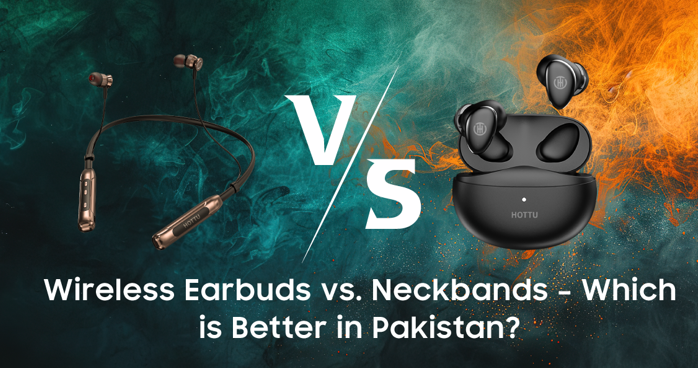In the fast-paced world of audio technology, choosing the right pair of headphones can make all the difference in your daily routine. Whether you’re commuting through the bustling streets of Lahore, working out in a Karachi gym, or simply relaxing at home in Islamabad, wireless audio devices have become essential. Among the most popular options are wireless earbuds and neckbands. But which one reigns supreme, especially in the context of Pakistan’s unique market, climate, and lifestyle? In this comprehensive guide, we’ll dive deep into the comparison between wireless earbuds and neckbands, helping you decide what’s best for your needs. As a content marketing expert with over a decade of experience in tech accessories like earbuds and power banks, I’ve seen how these devices evolve and adapt to user preferences. Let’s explore why wireless earbuds, in particular, are gaining massive traction in Pakistan.
Understanding Wireless Earbuds: The True Wireless Revolution
Wireless earbuds represent the pinnacle of modern audio convenience. These compact devices, often referred to as true wireless stereo (TWS) earbuds, eliminate all cords, connecting seamlessly via Bluetooth to your smartphone, laptop, or tablet. In Pakistan, where mobile usage is skyrocketing—thanks to affordable data plans and widespread smartphone adoption—wireless earbuds have become a go-to choice for many.
What sets wireless earbuds apart is their design. Each earpiece is independent, fitting snugly into your ear canal or resting on the outer ear, depending on the model. Brands like those available on hottu.pk offer a variety of wireless earbuds that cater to different preferences, from noise-cancelling features to sweat-resistant builds ideal for Pakistan’s humid summers. For instance, models with ergonomic designs ensure they stay put during intense activities, making them perfect for joggers in urban parks or students rushing between classes.
The appeal of wireless earbuds in Pakistan lies in their portability. Weighing just a few grams, they slip easily into your pocket or bag, unlike bulkier alternatives. With advancements in battery technology, many wireless earbuds now provide up to 8-10 hours of playback on a single charge, extendable via their charging case. This is crucial in a country where power outages are common, and users need devices that last through long days without frequent recharges.
Moreover, wireless earbuds often come packed with smart features. Touch controls allow you to manage calls, skip tracks, or activate voice assistants like Google Assistant or Siri without touching your phone. In Pakistan’s diverse audio market, where consumers demand value for money, wireless earbuds deliver high-quality sound with deep bass and clear highs, rivaling wired options from yesteryears.
See also: The Impact of Quantum Computing on Modern Technology
Decoding Neckbands: The Reliable Hybrid Option
Neckbands, on the other hand, offer a middle ground between traditional wired headphones and fully wireless ones. These devices feature two earpieces connected by a flexible band that rests around your neck, with Bluetooth connectivity eliminating the need for a direct wire to your device. Popular in Pakistan for their affordability and durability, neckbands have been a staple for budget-conscious users since the early days of Bluetooth audio.
In essence, neckbands provide stability during movement. The neckband design prevents the earpieces from falling out easily, which is a boon for active lifestyles. Whether you’re navigating crowded bazaars in Rawalpindi or cycling through Peshawar’s streets, the band keeps everything secure. Many neckbands also include magnetic earbuds that snap together when not in use, reducing the risk of loss—a common concern in Pakistan’s hectic urban environments.
Battery life is another strong suit for neckbands. Without the constraints of tiny individual batteries, they often boast 15-20 hours of continuous playback, making them ideal for long-haul bus rides or extended work shifts. In Pakistan, where public transport is a daily reality for millions, this extended runtime means fewer interruptions.
Sound quality in neckbands can be impressive, especially in models with larger drivers that handle bass-heavy music genres popular among Pakistani youth, like Sufi rock or Bollywood tracks. Additional features like built-in microphones for calls and inline controls add to their practicality. However, neckbands might feel slightly more cumbersome than wireless earbuds, as the band can get warm in Pakistan’s scorching heat, potentially causing discomfort during prolonged use.
Key Comparisons: Sound Quality and Audio Performance
When pitting wireless earbuds against neckbands, sound quality is often the first battleground. Wireless earbuds excel in delivering immersive audio experiences, thanks to advanced drivers and equalization options. In Pakistan, where music streaming apps like Spotify and YouTube Music are booming, users appreciate the balanced sound profiles that wireless earbuds provide. For example, many models feature active noise cancellation (ANC), which blocks out the cacophony of traffic horns and street vendors, allowing you to focus on your playlist or podcast.
Neckbands, while not always matching the premium audio finesse of high-end wireless earbuds, hold their own with robust bass and clear vocals. They’re particularly favored by those who prioritize volume over nuance, as their design allows for larger speakers. However, in noisy Pakistani settings like busy markets or construction sites, neckbands might leak more sound, reducing privacy compared to the in-ear seal of wireless earbuds.
Overall, if crystal-clear highs and adaptive sound are your priority, wireless earbuds edge out neckbands. But for everyday listening without the fuss, neckbands remain a solid contender.
Battery Life and Charging: Endurance in a Power-Challenged Nation
Pakistan’s inconsistent electricity supply makes battery life a critical factor. Wireless earbuds typically offer 4-8 hours per charge, with cases providing multiple recharges for a total of 20-30 hours. This modular approach is convenient, as you can pop them back into the case during short breaks. Brands on platforms like hottu.pk emphasize quick-charging capabilities, where a 10-minute charge yields hours of use—perfect for on-the-go Pakistanis.
Neckbands shine here with their single, larger battery, often lasting 12-24 hours straight. No need for a separate case; just plug in via USB-C when needed. This makes them reliable for rural areas or long travels where charging points are scarce. However, if the battery dies, you’re out of luck until you recharge, unlike wireless earbuds where one earpiece can sometimes function independently.
In Pakistan’s context, where solar-powered charging is gaining popularity, both options adapt well, but neckbands might appeal more to those seeking uninterrupted longevity.
Comfort and Fit: Adapting to Pakistani Lifestyles
Comfort is subjective, but in Pakistan’s varied climates—from the arid deserts of Sindh to the rainy hills of the north—it’s non-negotiable. Wireless earbuds provide a minimalist fit, with silicone tips that create a secure seal. This is great for sweat-prone activities, as many are IPX-rated for water resistance. However, finding the right fit can be tricky; ill-fitting earbuds might cause ear fatigue after hours of use.
Neckbands offer a looser, over-the-ear or in-ear style with the band distributing weight. They’re less likely to fall out during vigorous movements, like dancing at a wedding mehndi or playing cricket in the park. Yet, the neckband can feel restrictive or sweaty in hot weather, a common complaint in cities like Multan during summer peaks.
For most Pakistanis balancing work, family, and leisure, wireless earbuds win for all-day comfort, especially if you opt for models with customizable ear tips.
Portability and Durability: On-the-Move Essentials
Portability is where wireless earbuds truly dominate. Their tiny size means they fit anywhere, from a student’s backpack to a professional’s briefcase. In Pakistan’s crowded public transport, this discreteness prevents theft or loss. Durability-wise, many wireless earbuds are built tough, with reinforced cases that withstand drops and dust—prevalent in dusty roads of Quetta or Lahore.
Neckbands are portable too but bulkier, often requiring coiling for storage. They’re durable against tugs and pulls, thanks to the flexible band, making them suitable for labor-intensive jobs. However, the exposed wires between the band and earpieces can wear out over time, especially in humid conditions.
In a mobile-first country like Pakistan, the edge goes to wireless earbuds for effortless carry.
Price and Value: Navigating Pakistan’s Market
Affordability drives tech adoption in Pakistan. Wireless earbuds range from budget options under PKR 2,000 to premium ones exceeding PKR 10,000, offering great value through features like app integration. Sites like wireless-earbuds showcase a selection that balances quality and price, appealing to middle-class consumers.
Neckbands are generally cheaper, starting at PKR 2,000, making them accessible to a broader audience, including students and entry-level workers. They provide solid performance without the premium tag, but might lack the latest tech bells and whistles.
Value-wise, wireless earbuds offer more future-proofing, as the market shifts toward true wireless tech.
Features and Connectivity: Tech-Savvy Choices
Modern wireless earbuds boast features like multipoint connectivity, allowing seamless switching between devices—a must for Pakistanis juggling work calls and personal music. Low-latency modes enhance gaming and video watching, popular on platforms like PUBG Mobile.
Neckbands keep it simple with reliable Bluetooth 5.0 connectivity and built-in remotes. They’re less prone to signal drops in crowded areas, but miss out on advanced ANC or spatial audio.
For tech enthusiasts in Pakistan’s growing startup scene, wireless earbuds provide more innovation.
Which is Better in Pakistan? A Contextual Verdict
In Pakistan, the choice between wireless earbuds and neckbands boils down to lifestyle. If you’re urban, tech-forward, and value freedom from wires, wireless earbuds are superior. They align with the country’s youthful demographic, where over 60% of the population is under 30 and increasingly adopts smart tech. Factors like heat, dust, and mobility favor their compact design.
Neckbands suit those needing marathon battery life and affordability, perhaps in rural or labor-focused settings. However, with e-commerce booming—platforms like Daraz and local sites making imports easier—wireless earbuds are becoming more accessible.
Ultimately, wireless earbuds edge out as the better overall choice in Pakistan for their versatility and modern appeal.
Conclusion: Make the Switch to Wireless Freedom
As audio tech evolves, wireless earbuds stand out as the future-proof pick for Pakistanis seeking convenience, quality, and style. While neckbands have their niche, the shift toward true wireless is undeniable. Whether for calls, music, or workouts, investing in reliable wireless earbuds enhances your daily life. Dive into the world of audio excellence and discover how these devices can transform your routine.


